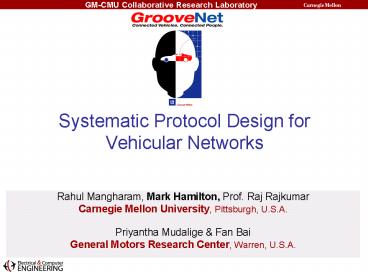Systematic Protocol Design for Vehicular Networks - PowerPoint PPT Presentation
1 / 18
Title:
Systematic Protocol Design for Vehicular Networks
Description:
Systematic Protocol Design for Vehicular Networks. Rahul Mangharam, Mark Hamilton, ... Telematics. Traffic Reporting. Safety. Solution Approach. Problem. Protocol ... – PowerPoint PPT presentation
Number of Views:56
Avg rating:3.0/5.0
Title: Systematic Protocol Design for Vehicular Networks
1
Systematic Protocol Design for Vehicular Networks
- Rahul Mangharam, Mark Hamilton, Prof. Raj
Rajkumar - Carnegie Mellon University, Pittsburgh, U.S.A.
- Priyantha Mudalige Fan Bai
- General Motors Research Center, Warren, U.S.A.
2
Current State of Vehicular Network Design
VANET Hybrid-Simulator
3
GrooveNet Protocol Design Approach
Rapid Prototyping
Model Validation
4
Protocol Requirements
Bounded Broadcast
Scheduled Latency Storm
Flooding
Message Disconnected Adaptive
Persistence Network
Rebroadcast
End-to-End Rapid Topology ?
Connectivity Changes
Heterogeneous Networks
Alert Zone with delay-sensitive
messages
Warning Zone with persistent messages
5
Why do we need Hybrid Simulation?
Vehicle Operations Director (VOD)
2
4
Cellular Link
Cellular Link
3
Real Vehicle
1
Real Vehicle DSRC Link
Virtual Vehicles (Simulated on VOD) V0 V1
V2 V3 V4 . Vn-1 Vn
- Key Benefits
- Scaling Effects - Observe impact of Traffic
Density - Remote Monitoring of On-road Experiments
- Rapid Prototyping Same models from Simulation
to Deployment - Model Validation Evaluate Correctness
6
GrooveNet Hybrid Simulator Design
Event Queue
GrooveNet Simulator Core
7
Test Setup
8
Boston Case Study
9
New York Unbounded Flooding
10
New York Geographic Flooding
11
Car Following Model
12
Traffic Signal Model
13
Modular Architecture
Traffic Light Model
Infrastructure Node Model
14
On-road Vehicular Networking Platform
15
Location Division Multiple Access(Focus for 2007)
Alert Zone
200m Location Slot
1
2
3
4
1
2
Transmission Time Slots
GOAL Achieve Bounded End-to-End Latency in Alert
Zone (500-1,500m) Using GPS PPS (Pulse Per
Second) sub 30ms delay per hop We impose a
TDMA schedule based on the vehicles location
16
Adaptive Broadcast for Persistent Messagesin
Warning Zone(Focus for 2007)
Aggressive Rebroadcast (Message Propagation at
Frontier)
Rebroadcast Rate (Hz)
Lazy Rebroadcast (Maintain Connectivity)
Max. Message Propagation Distance (m)
Current vehicles position
17
(No Transcript)
18
(No Transcript)






























